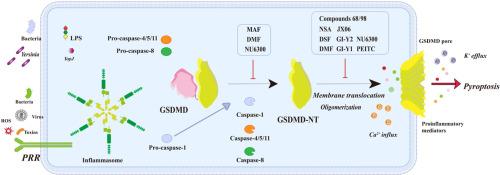气凝胶蛋白D小分子抑制剂研究进展
IF 5.9
2区 医学
Q1 CHEMISTRY, MEDICINAL
引用次数: 0
摘要
Gasdermin D (GSDMD)作为焦亡的关键介质,通过caspase介导的裂解形成膜孔,驱动促炎细胞死亡,与败血症、癌症和自身免疫性疾病的发病密切相关。GSDMD抑制剂开发的最新进展主要集中在关键步骤:阻断caspase介导的裂解,抑制n端寡聚化或破坏孔形成。例如靶向Cys191/192的小分子药物,如DMF、DSF、NSA、NU6300,以及靶向其他残基的分子,如mafenide、GI-Y1、GI-Y2。caspase-GSDMD复合物的高分辨率结构和孔隙组装机制的阐明促进了新的靶向策略的出现,为合理设计提供了关键基础。尽管取得了进展,但脱靶效应和低临床转译率等挑战仍然存在。优化特异性和探索疾病特异性应用仍然是推进这些抑制剂作为治疗剂的关键。目前的研究重点是通过结构导向优化、药物再利用、精准给药系统创新和协同机制方法,开发临床可翻译、高效、安全的gsdmd靶向治疗。本文章由计算机程序翻译,如有差异,请以英文原文为准。


Progress in small-molecule inhibitors of gasdermin D
As a key mediator of pyroptosis, Gasdermin D (GSDMD) drives pro-inflammatory cell death through caspase-mediated cleavage to form membrane pores, which is closely linked to the pathogenesis of sepsis, cancer, and autoimmune diseases. Recent advances in GSDMD inhibitor development primarily focus on key steps: blocking caspase-mediated cleavage, inhibiting N-terminal oligomerization, or disrupting pore formation. Examples include small-molecule drugs targeting Cys191/192 such as DMF, DSF, NSA, and NU6300, as well as molecules targeting other residues like mafenide, GI-Y1, and GI-Y2. The elucidation of high-resolution structures of caspase-GSDMD complexes and pore assembly mechanisms has facilitated the emergence of novel targeting strategies, providing a critical basis for rational design. Despite progress, challenges such as off-target effects and low clinical translation rates persist. Optimizing specificity and exploring disease-specific applications remain pivotal to advancing these inhibitors as therapeutic agents. Current research focuses on developing clinically translatable, highly effective, and safe GSDMD-targeted therapies through structure-guided optimization, drug repurposing, innovations in precision delivery systems, and synergistic mechanism approaches.
求助全文
通过发布文献求助,成功后即可免费获取论文全文。
去求助
来源期刊
CiteScore
11.70
自引率
9.00%
发文量
863
审稿时长
29 days
期刊介绍:
The European Journal of Medicinal Chemistry is a global journal that publishes studies on all aspects of medicinal chemistry. It provides a medium for publication of original papers and also welcomes critical review papers.
A typical paper would report on the organic synthesis, characterization and pharmacological evaluation of compounds. Other topics of interest are drug design, QSAR, molecular modeling, drug-receptor interactions, molecular aspects of drug metabolism, prodrug synthesis and drug targeting. The journal expects manuscripts to present the rational for a study, provide insight into the design of compounds or understanding of mechanism, or clarify the targets.

 求助内容:
求助内容: 应助结果提醒方式:
应助结果提醒方式:


